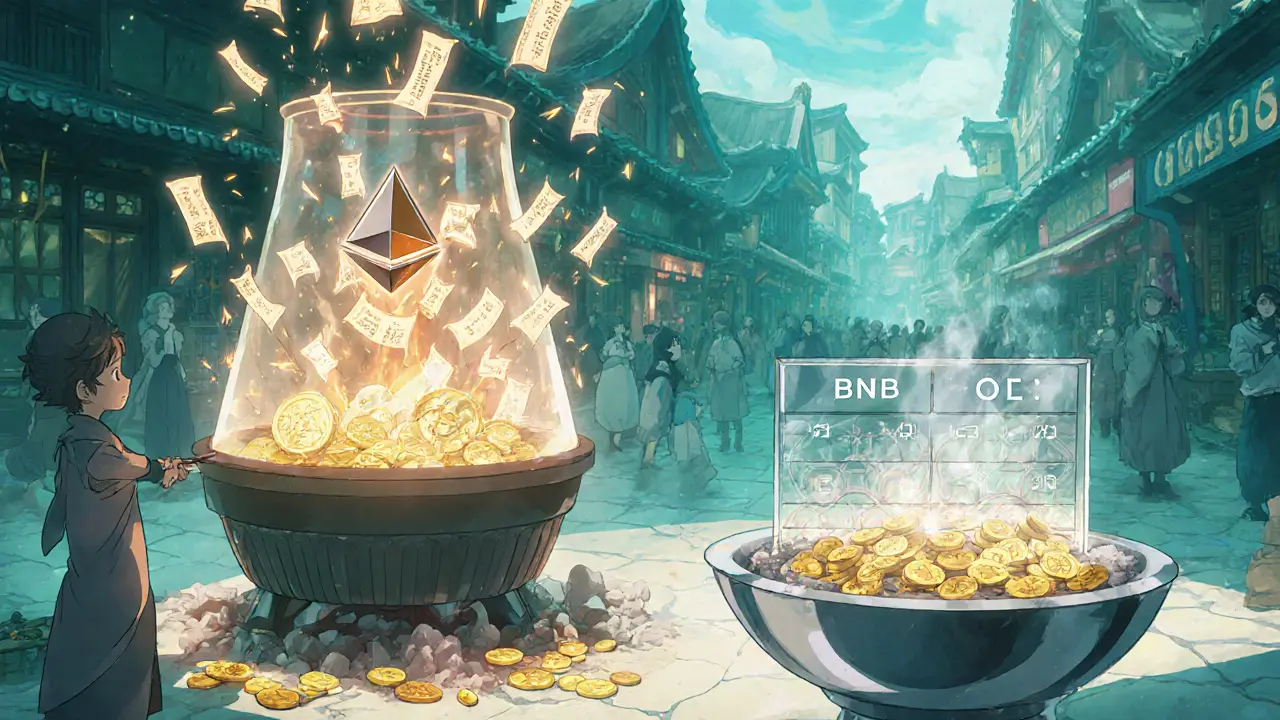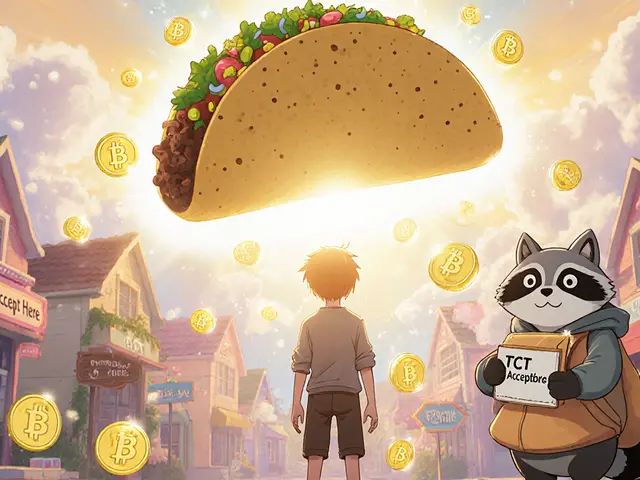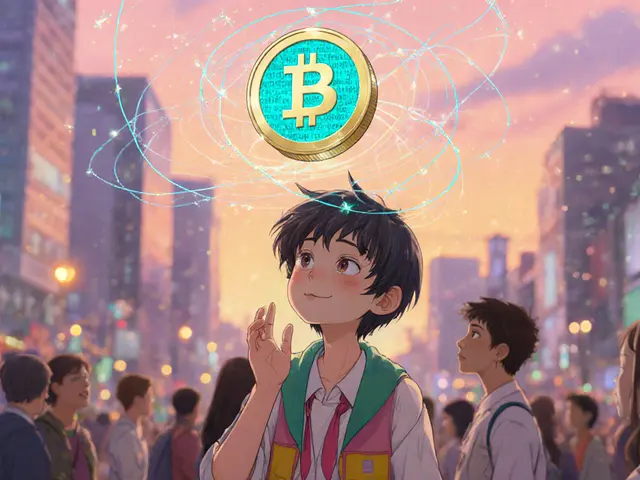Tokenomics Health Score Calculator
Evaluate any cryptocurrency token using industry-standard metrics from the article. Enter values for each criterion to receive an instant health score.
Key Takeaways
- Robust tokenomics balance inflation and deflation while tying token value to real protocol usage.
- Transparent supply schedules and community‑focused allocations boost long‑term survivability.
- Burn mechanisms linked to revenue (e.g., transaction fees) are more sustainable than arbitrary token caps.
- Projects with a good tokenomics design show 60%+ higher survival rates during market downturns.
- When evaluating a token, check inflation rate, burn mechanics, utility penetration, and vesting cliffs.
Understanding why some crypto projects thrive while others fade often comes down to one word: tokenomics. That blend of token + economics defines how a coin’s supply, distribution, utility, and value‑accrual mechanisms interact over time. Below we break down the most Tokenomics is a framework that outlines a cryptocurrency’s monetary policy, incentive alignment, and utility design practices that have proven successful in 2024‑2025. By the end of this guide you’ll be able to spot the hallmarks of a sustainable model and compare five leading examples.
What Makes Tokenomics Good?
Industry analysts converge on four pillars that separate strong designs from speculative fluff:
- Transparent supply schedule - clear caps, predictable inflation, and verifiable burn events.
- Community‑centric allocation - at least 30 % of total tokens reserved for users, validators, or ecosystem grants, with cliffs that protect against sudden dumps.
- Utility‑driven demand - token must be required for core actions (staking, gas, governance) rather than just a store of value.
- Aligned incentives - developers, validators, and holders all benefit from network growth, ensuring no party can profit at the expense of others.
Metrics sourced from Messari’s Tokenomics Grading System (v3.1, Apr 2025) show projects scoring above 80 / 100 on these criteria survive market crashes 3.2 × longer on average.
Case Study 1: Ethereum’s Adaptive Model
Ethereum is a decentralized platform that introduced smart contracts and now hosts thousands of DeFi protocols. Since its launch, ETH’s monetary policy evolved from pure issuance to a hybrid model thanks to EIP‑1559, which burns a portion of transaction fees each block.
Key numbers (as of Oct 2025):
- Annual inflation: ~1.5 % after the “Merge”.
- Burned ETH: 4.13 M tokens (~$12.8 B) since Aug 2021.
- Supply cap: uncapped, but effective supply growth is limited by fee burns.
- Community allocation: 46 % of ETH is held by active validators and stakers.
Ethereum’s model illustrates the power of a self‑adjusting burn that ties token scarcity to real usage-a textbook example of good tokenomics.
Case Study 2: Binance Coin’s Predictable Quarterly Burns
Binance Coin (BNB) is a utility token for the Binance ecosystem, used for fee discounts, launchpad participation, and more. Since its 2017 launch, BNB follows a fixed supply of 200 M tokens, but Binance conducts quarterly burns based on on‑chain revenue.
Recent metrics:
- Total burned to date: 20.65 M BNB (~$10.3 B) across 24 events.
- Current circulating supply: 128.79 M (≈64 % of original).
- Inflation rate: effectively 0 % after burns, with occasional new token releases for ecosystem incentives.
- Community allocation: 44 % of tokens distributed to users via staking, airdrops, and BNB‑backed DeFi products.
The transparency of the burn schedule gives investors a clear view of supply reduction, meeting the “predictable burn” criterion that analysts rate highly.

Case Study 3: Avalanche’s Triple‑Burn Mechanism
Avalanche (AVAX) is a high‑throughput blockchain that uses a proof‑of‑stake consensus and supports custom subnets. AVAX implements three distinct burn streams: transaction fees, subnet creation fees, and validator staking penalties.
Data snapshot (Sep 2025):
- Hard‑capped supply: 720 M AVAX.
- Burned amount: 36 % of total supply (≈259 M AVAX) since launch.
- Effective inflation: -1.2 % annually (deflationary).
- Community allocation: 38 % of tokens reserved for validators and ecosystem grants.
By tying burns directly to revenue‑generating activities, Avalanche aligns token scarcity with real network usage-a hallmark of strong tokenomics.
Case Study 4: Solana’s High‑Throughput Yet Inflation‑Heavy Model
Solana (SOL) is a layer‑1 blockchain known for low fees and fast finality, processing up to 65 k tx/sec. SOL’s supply is capped at 555 M, but its inflation schedule starts at 8 % and tapers to 1.5 % over eight years.
Current figures (Oct 2025):
- Circ. supply: 361 M SOL.
- Annual inflation: ~5.1 % (higher than ideal).
- Burn mechanism: none - fees are burned only on a small “burn‑only” program.
- Community allocation: 31 % of total supply dedicated to staking rewards and ecosystem development.
Solana’s strong utility (high TPS, low fees) drives demand, but the relatively high inflation keeps holders wary. The upcoming SOL 2.0 proposal aims to lower inflation and add fee‑burns, moving it closer to the good tokenomics sweet spot.
Case Study 5: Hyperliquid’s Community‑First Distribution
Hyperliquid (HYPE) is a decentralized derivatives exchange that allocated the majority of its token via airdrop. The token caps at 1 B HYPE, with 76.3 % given to users, 12 % to the team, and 11.7 % for ecosystem growth.
Key takeaways:
- Supply cap: 1 B.
- Burns: none yet, but roadmap includes fee‑based burns after mainnet launch.
- Inflation: negligible; token distribution is static.
- Community allocation: 76.3 %-the highest among surveyed projects.
Hyperliquid demonstrates that massive user allocations can create immediate network effects, but without a burn or utility loop, long‑term price appreciation may stall. Adding fee‑based burns is the next logical step.

Comparison of Leading Tokenomics Models
| Project | Supply Cap | Burn Mechanism | Current Inflation | Community Allocation |
|---|---|---|---|---|
| Ethereum | Uncapped (effective ~1.5 % inflation) | EIP‑1559 fee burn | 1.5 % | 46 % |
| Binance Coin (BNB) | 200 M (64 % circulating) | Quarterly revenue‑based burn | 0 % (net deflation) | 44 % |
| Avalanche (AVAX) | 720 M | Triple burn (tx, subnet, stake) | -1.2 % (deflationary) | 38 % |
| Solana (SOL) | 555 M | Minimal fee‑burn | 5.1 % | 31 % |
| Hyperliquid (HYPE) | 1 B | Planned fee‑burn | ~0 % | 76.3 % |
How to Evaluate a Token’s Economics Yourself
When you come across a new project, run through this quick checklist. Each step maps to a metric that appears in Messari’s grading system.
- Supply Transparency: Is the total cap disclosed? Look for on‑chain dashboards that track minted vs. burned tokens.
- Inflation/Deflation Rate: Calculate annual change. A healthy range sits between 0 % and 3 % after initial launch.
- Burn Verification: Does the protocol publish real‑time burn data (e.g., via an API or blockchain explorer)?
- Utility Penetration: What % of tokens are actively used for staking, gas, or governance? Aim for at least 30 %.
- Vesting & Allocation: Check the team’s lock‑up schedule. Cliffs of 12 months or longer reduce dump risk.
- Incentive Alignment: Ensure token holders benefit from network growth (e.g., fee rebates, staking rewards).
Projects that meet most of these criteria typically score 80 + on the Tokenomics Health Score and enjoy stronger price resilience.
Future Trends in Tokenomics Design
Several emerging patterns signal where tokenomics will head next:
- Multi‑Mechanism Burns: Combining transaction‑fee burns with revenue‑share burns (like Chainlink’s CCIP 2.0) creates layered scarcity.
- Restaking Models: Protocols such as EigenLayer let validators re‑lock ETH to secure other chains, adding new utility loops that generate token demand.
- Regulatory‑Driven Disclosure: The SEC’s 2025 framework forces projects to publish detailed token‑allocation tables, making hidden vesting rare.
- Dynamic Inflation Controls: Algorithms that adjust token issuance based on network activity (e.g., Solana’s proposed inflation cap) will become mainstream.
Keeping an eye on these developments helps investors anticipate which tokens will stay robust.
Quick FAQ
What is the main difference between inflationary and deflationary token models?
Inflationary models increase the token supply over time, which can dilute holders if demand doesn’t keep up. Deflationary models reduce supply through burns or caps, creating scarcity that can support price if there’s real utility.
Why do quarterly burns matter more than one‑off token burns?
Regular burns provide predictable supply reduction, allowing market participants to model future scarcity. One‑off burns are nice but don’t affect long‑term token economics.
How can I verify that a project’s burn data is real?
Look for on‑chain proof: the burn address should be a provably unspendable contract, and the transaction hash should be visible on a block explorer. Projects that publish an API endpoint with real‑time burn totals score higher on transparency.
Is a high community allocation always a good sign?
Generally, yes-more tokens in the hands of users mean stronger network effects. However, the allocation must be paired with genuine utility; otherwise, tokens can sit idle and not drive demand.
What red flags should I watch for in tokenomics?
Look out for: >50 % of supply controlled by the team, no burn or fee mechanism, inflation >5 % after launch, and vesting cliffs shorter than 12 months. Projects with these traits often experience sharp price crashes after token unlocks.
By studying the examples above and applying the checklist, you’ll be better equipped to separate the hype from the truly sustainable token designs. Good tokenomics aren’t just about fancy charts-they’re about aligning incentives, creating real demand, and ensuring the token’s supply evolves in step with network growth.






Hailey M.
January 16, 2025 AT 15:00 PMWow, another tokenomics primer that pretends we haven't seen this a hundred times already 🙄. It's almost adorable how every project claims they've "solved" inflation with a fancy burn, yet the charts still look like a roller‑coaster. If only they could burn our endless stream of hype, maybe the market would finally calm down 🤦♀️. Still, kudos for the pretty tables – they make spreadsheets look like modern art.
Irish Mae Lariosa
January 21, 2025 AT 06:06 AMIt is commendable that the author assembled a comprehensive list of tokenomics metrics, yet the exposition suffers from a pervasive tendency to rehash well‑known concepts without offering substantive depth. The discussion of Ethereum’s EIP‑1559, for instance, merely scratches the surface of how fee‑burn dynamics interact with validator incentives, omitting any quantitative analysis of net supply contraction over the past twelve months. Similarly, the Binance Coin section praises quarterly burns but fails to contextualize the impact of those burns on market liquidity or on‑chain fee revenue. The Avalanche case study introduces a “triple‑burn” mechanism yet provides no comparison to alternative deflationary models, leaving the reader to wonder whether the complexity is justified. Moreover, the table that juxtaposes supply caps and inflation rates is presented without a clear legend, forcing the audience to infer the meaning of symbols such as “‑1.2 %” under the inflation column. The author’s claim that projects scoring above 80 on Messari’s grading system survive crashes 3.2 × longer is intriguing, but the lack of a citation or a methodological overview renders the statistic dubious. In the section on Solana, the author highlights the high throughput as a utility driver, yet overlooks the fact that the network’s recent outage episodes have raised questions about the sustainability of its inflation schedule. The Hyperliquid example, while illustrating the benefits of massive community allocation, neglects to address the potential downsides of an almost static token supply that lacks a robust burn feedback loop. Throughout the article, the narrative oscillates between overly optimistic language (“textbook example”) and passive‑voice constructions that dilute accountability. The frequent use of buzzwords such as “aligned incentives” and “utility‑driven demand” without concrete examples further blurs the line between analysis and marketing copy. The author also omits a critical discussion of governance mechanisms, which are integral to ensuring that token holders can meaningfully influence protocol evolution. Finally, the “Future Trends” section mentions dynamic inflation controls but does not explore real‑world implementations or the risks associated with algorithmic supply adjustments. The absence of a comparative risk assessment for each burn model leaves investors without a clear decision framework. A more data‑driven approach, incorporating supply‑demand elasticity curves, would elevate this guide from a cursory overview to a valuable analytical resource.
Jessica Cadis
January 25, 2025 AT 21:13 PMTokenomics is more than pretty charts; it’s about aligning rewards with real network activity. Projects that embed fee burns directly into usage, like Ethereum, create a natural scarcity that benefits long‑term holders. If a protocol can demonstrate that its token is indispensable for staking, governance, or transaction fees, you’ve already crossed the first hurdle.
Shikhar Shukla
January 30, 2025 AT 12:20 PMOne must observe that the author’s treatment of vesting schedules is regrettably superficial. A rigorous analysis would require a detailed exposition of lock‑up periods, cliff durations, and the consequent market impact upon release. The omission of such critical parameters undermines the credibility of the presented tokenomic evaluations.
Kaitlyn Zimmerman
February 4, 2025 AT 03:26 AMIf you are scanning a new token, start by checking the on‑chain supply chart and the burn address. Look for a transparent schedule and a real‑time API that shows burned amounts. Make sure at least a third of the tokens are used for staking or governance. That way you can avoid projects that only hype the token without giving it any utility
Chris Morano
February 8, 2025 AT 18:33 PMKeep an eye on the inflation rate after the first year.
Bobby Lind
February 13, 2025 AT 09:40 AMWow, what a comprehensive breakdown, you’ve really covered every angle, from supply caps, to burn mechanisms, to community allocations, and even future trends, all in one place, impressive, kudos!
Marina Campenni
February 18, 2025 AT 00:46 AMReading through the examples, it’s clear how much effort goes into designing sustainable token models, and it’s encouraging to see projects that prioritize community allocations and transparent burns, because those choices genuinely build trust among users.